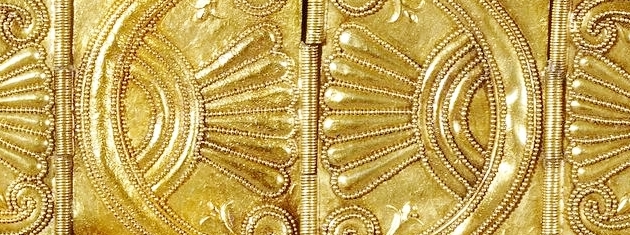Phoenician Gold Jewellery
Aimée Bou Rizk, Museum Assistant at the Archaeological Museum / American University of Beirut (AUB).
Nesrine Aad, Research Assistant at the Archaeological Museum / American University of Beirut (AUB).
September 2021
The Phoenicians, a Levantine people, are well known for spreading long-lasting innovations to Europe such as the alphabet, murex-based purple dye, jewellery making and masterful craftsmanship. But above all, the Phoenicians are renowned for their seafaring prowess and far-flung trade.
The Phoenicians were an ancient civilization consisting of city-states along the Mediterranean essentially in modern-day Lebanon, extending north to Arwad in Syria and south to Acre in Palestine. Prior to the Iron Age the inhabitants of these city-states were called the Canaanites. The Greeks called these people “Phoenicians”, after their well-known purple dye, dubbed Phoe Ni Kes. They were renowned innovators in various fields, the most famous one is the invention of the modern-day writing system, which later on gave birth to the Greek Alphabet
“The need to feel accepted, to belong, can be as important as the needs we fulfill in caring for our bodies. A sense of identity and self-esteem is not a frill, so belonging reflects a need, too.” (1)
The first type of jewellery was not made with the same material we use today. They were made of feathers, bones, shells, and colored pebbles known as gems. Gems have always been a source of admiration for their beauty and durability and made into adornments. Diamonds were not popular until people learned how to cut them to show their brilliance, which began in Europe sometime around the 1300’s. Some jewellery items derive from functional objects. Pins and brooches originated from the clasps that held clothing together. Rings and pendants were used for early seals and signs of identification, rank, and authority.
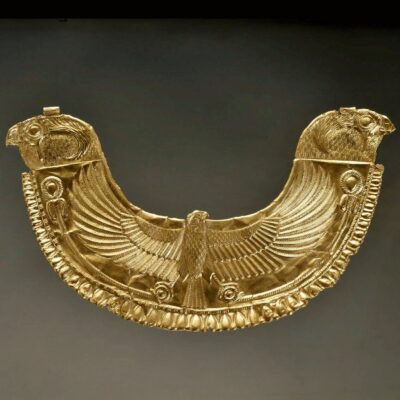
Lebanon, Fig (1) Byblos - Pectoral imitating an Egyptian ousekh necklace. Byblos royal necropolis tomb III, Lebanon, (2100 - 1550 BC), Gold, Louvre Museum. AO 9093. © 2006 Musée du Louvre / Raphaël Chipault.
Jewellery was worn from prehistoric times around 25,000 years ago. The first decorations stemmed from the hunt; teeth, claws, horns, and bones. Hunters believed that wearing trophies would bring them good luck for the next hunt. This tradition developed through history as jewelry was worn as amulets to protect against bad luck and illness and for its magical properties. Later on, it came to symbolize human connection and commitment. Bracelets were worn by slaves to show who they belonged to. During the medieval period in Europe only the wealthy and high-ranking church officials were allowed to wear gemstones as a sign of wealth and power. The less fortunate wanting to imitate them would wear less expensive material that will add color and life to their clothes. Nowadays for example, wedding rings represent the commitment two people had for each other.
Phoenicians were never the type of people who made huge discoveries in science but in every aspect of life they had their own touch to make things easier or look better. For example, they invented the blowing technique that made glass transparent and easier to work, and they invented the “cloisonné” technique in jewellery making. Jewelry making in Phoenicia had been present from the Canaanite period (i.e. Early Bronze Age). It is much more than a handicraft; it is an art related to a rich Levantine artistic tradition.
Treasures found in Byblos and Ugarit, dating III° and II° millennia have included pectorals and gold medallions, worked in “repoussé” or “cloisonné”, inspired by Egyptian styles. Decorative motifs and patterns of these centuries were common during the first millennium of the Phoenician period.
Gold was never the only material used. Different materials served for jewelry manufacturing, varying from gold to silver, bronze, precious stone, polychrome glasses, carnelian and faience, depending on the trend. The survival of the jewelry also varies from one material to another; this is why gold is the most commonly- found, but silver was also used yet not abundantly unearthed because of its degradation with time.
These jewellery pieces were typically discovered in tombs where the deceased was buried with their jewels and around temples as offerings for the gods. Most of the objects were found in the Phoenicians colonies such as Carthage in Tunis, Kition in Cyprus, in Italy, Morocco, Spain and Portugal with some finds in Byblos, Sidon and Tyre.
Treasures found in Byblos, dating from 3000 and 2000 BC include wide and massive necklaces covering the whole chest area, called pectoral, and made to protect the heart and lungs (Fig.1).
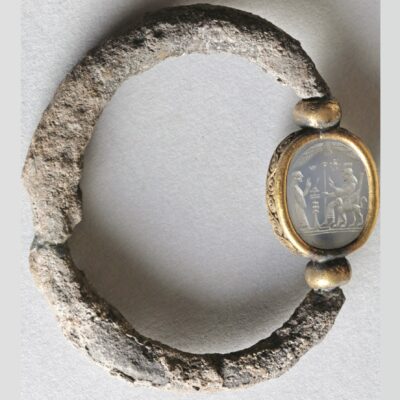
Lebanon, Fig (2) Silver bracelet with an amethyst intaglio stone set in a gold bezel, Magharat Tabloun, Sidon, Lebanon, (5th - 4th c. BC), Gold, Silver, Semiprecious Stone, Beirut National Museum. 16157. © Directorate General of Antiquities / National Museum of Beirut.
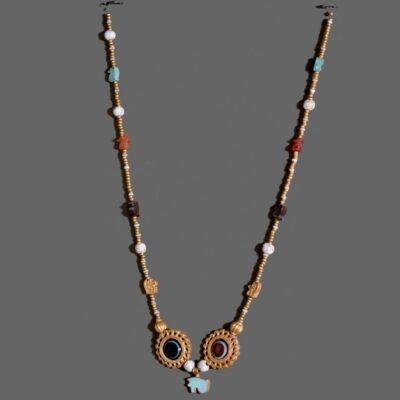
Lebanon, Fig (3) Sidon, Necklace, Magharat Tabloun, Sidon, Lebanon, (5th c. BC), Gold, Semiprecious Stones, Beirut National Museum. 16508. © Directorate General of Antiquities / National Museum of Beirut.
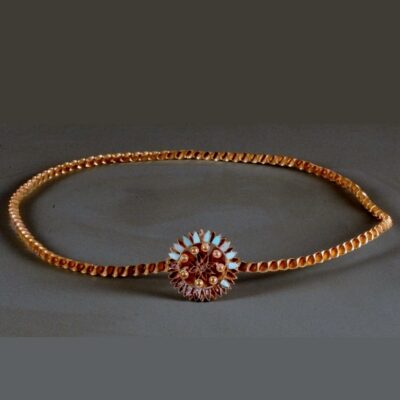
Lebanon, Fig (4) Sidon - Necklace, Magharat Tabloun, Sidon, Lebanon, (5th c. BC), Gold, Semiprecious Stones, Beirut National Museum. 16508. © Directorate General of Antiquities / National Museum of Beirut.
On the outskirt of Sidon, several gold jewelleries were discovered in Magharat Tabloun necropolis, and now exhibited at the National Museum of Beirut. A bracelet/seal (5th – 4th c. BC) is an example of a combination of material with the bracelet made of silver and the amethyst intaglio stone seal carefully wrapped in a delicately gold bezel (Fig 2). The work is exquisite from the coiled spiral patterns incision of the golden outside frame to the work of art on the precious stone. On the right, a female figure (perhaps the goddess Astarte) is seated on a throne, flanked by sphinxes, with a raised left hand and holding a long scepter in her right. On the left, a figure clad in a Persian style garment stands with both hands raised in a praying gesture. Between the two is an incense burner and above them a winged sun-disk and a star. A necklace (5th c. BC) combines gold and semiprecious stones (Fig 3). It is set with several gold, agate, turquoise, cornelian and coral stones carved in the shape of the Eye of Horus, separated by small gold and white beads. The center piece consists of two agate stones in a golden frame imitating a pair of eyes and at the center a turquoise Eye of Horus set in a delicate gold frame hanging from a barrel loop between two engraved white beads. Also, from Magharat Tabloun, are a diadem with a central rosette (Fig 4) and gold signet rings incised with a scene depicting a lion attacking a stag from behind which is a popular oriental motif recurring in Phoenician art and culture (Fig 5). These signet rings were used to seal documents by pressing the intaglio designs into molten wax.
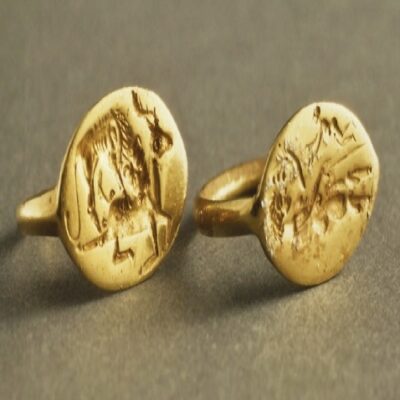
Lebanon, Fig (5) Signet ring, Magharat Tabloun, Sidon, Lebanon, (Mid-5th c. BC), Gold, Beirut National Museum. 16505. © Directorate General of Antiquities / National Museum of Beirut.
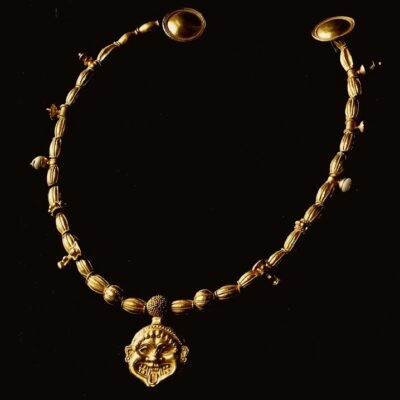
Lebanon, Fig (6) Necklace, Sidon, Lebanon, (5th c. BC), Gold, Beirut National Museum. 16509. © Directorate General of Antiquities / National Museum of Beirut.

Lebanon, Fig (7) Amulet in the shape of an eye, Sidon, Lebanon, (5th c. BC), Gold, Semiprecious Stone, Beirut National Museum. 16512. © Directorate General of Antiquities / National Museum of Beirut.
From Sidon, comes an interesting beaded necklace (5th c. BC) decorated with granulation and separated with suspended white beads supported by two semi-spherical gold sheets. Two spherical ribbed beads are positioned on the extremities of the necklace (Fig 6). The center is adorned by a pendant amulet in the shape of a light-hearted gorgon’s face in spectacular detail hanging from a spherical attachment covered entirely with granulations. Also a golden amulet in the shape of an eye is carved from blue and white agate (5th c. BC) (Fig 7).
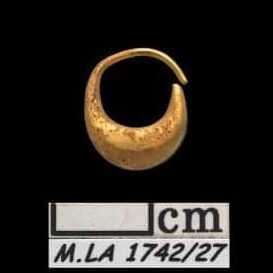
Cyprus Fig (8) - Earring, tomb of Kition, Cyprus, (8th c. BC), Gold, MLA 1742/27.

Cyprus Fig (9) - Ring, tomb of Kition, Cyprus, (8th c. BC), Gold, Ivory, MLA 1742/1.
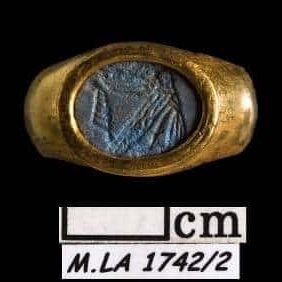
Cyprus Fig (10) - Ring, tomb of Kition, Cyprus, (8th c. BC), Gold, Semiprecious Stones, MLA 1742/2.
In Cyprus, a tomb was excavated at the southern outskirts of Larnaka that included a unique collection of jewellery adorning the deceased (earrings, rings, bracelets, necklace, fibula). The tomb dates to around the end of the 8th c. BC when Cyprus was under a strong oriental influence probably due to the strong Phoenician presence in Kition. Five earrings were found in the shape of a boat or leech typology (Fig 8). Three solid gold rings were discovered, one with ivory intaglio representing an ibis standing on its side while the background is filled with crossed lines representing bamboo or papyrus (Fig 9). The second is a gold ring with an indigo (sodalite) intaglio gem engraved depicting the Egyptian goddess of life Maat with a feather (Fig 10). The goddess Maat was the personification of the basic laws for all existence; she embodied the concepts of law, truth and world order. In Egyptian tradition, judges were regarded as priests of Maat. The third one is also a gold ring with faience intaglio possibly representing an ibis and a feather.
Two bracelets were found. The first is a ribbon bracelet with a circular granulated box setting, holding a round agate stone with an eye at the center (Fig 11). The second is made of a quadruple loop-in-loop chain with a scarab at its center set inside an oval bezel, with its sides at both ends smoothly rounded off (Fig 12). The scarab has on its lower part two goddesses seated side by side and three “beathyls” topped by a cartouche with a hieroglyphic inscription.
A necklace, consisting of seventeen beads and pendants of various shapes (Fig 13) and an inverted bow-shaped gold fibula, was also found (Fig 14).

Cyprus Fig (11) - Bracelet, tomb of Kition, Cyprus, (8th c. BC), Gold, Semiprecious Stones, MLA 1742/18.

Cyprus Fig (12) - Bracelet, tomb of Kition, Cyprus, (8th c. BC), Gold, Semiprecious Stones, MLA 1742/19.
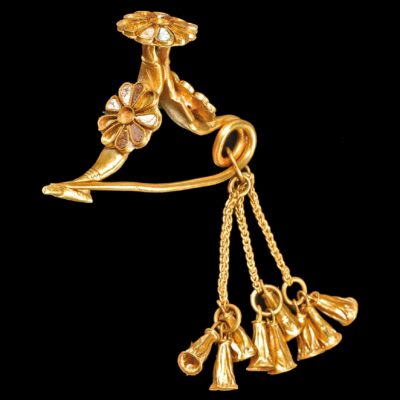
Cyprus Figure (14) - Fibula, tomb of Kition, Cyprus, (8th c. BC), Gold, Semiprecious Stones, MLA 1742/18.

Cyprus Fig (13) - Necklace, tomb of Kition, Cyprus, (8th c. BC), Gold, Semiprecious Stones, MLA 1742/18.

Tunis Fig (15) - Circular pendant. Carthage, Tunis, (700 - 500 BC), Gold, Louvre Museum. AO 3029. © 2007 RMN-Grand Palais (musée du Louvre) / Franck Raux.
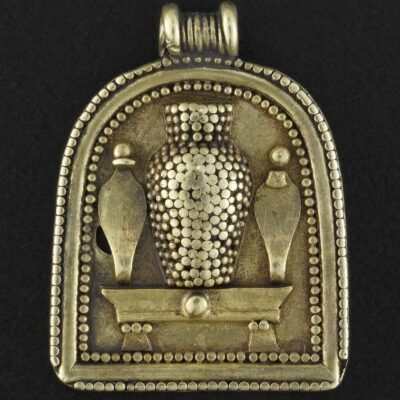
Tunis Fig (16) - Small pendant in the shape of a stele, Carthage, Tunis, (700 - 500 BC), Gold, Louvre Museum. AO 3028/AO 3795. © 2007 RMN-Grand Palais (musée du Louvre) / Franck Raux
In West Phoenicia, at Carthage, Tharros or in the Iberian Peninsula, the jewellery was inspired by the Levantine models for a long time, before applying their own representations. Carthage was a well-known Phoenician colony. Two medallions exposed at the Louvre museum demonstrate the fine “granulé” and hammered technique used in this period (7th – 6th c. BC). The first is a circular-shaped pendant with a winged disc, a solar disc and a crescent and two uraei with the solar disk (Fig 15). The second is a small constitutive of a stele representing an idol in the shape of a bottle flanked by two uraei with a solar disk (Fig 16).
The British Museum has several jewelleries from Tharros, Italy such as earrings from the 7th – 6th c. BC in the shape of ‘crux ansata’ or ankh (Fig 17), as well as a gold diadem with hinged gold plates decorated with palmettes and lotuses with granulation and gold wire (Fig18). From the 6th c. BC, comes a group of a signet-ring and gold earring (Fig 19). The signet ring consists of a green jasper scarab, with representations of probably murex shell , turtle, footprint, hawk and dolphin, set on a gold swivel. The earrings are composed of a ring of wire. Finally, a gold chain possibly a bracelet, consists of a steatite scaraboid in gold enclosure, with eight quadruple spacer-beads on either side (Fig 20). The scaraboid is engraved with cartouche flanked by hawks and uraei. The other side of the scaraboid is convex and carved with an eight-petal rosette.

Italy Fig (17) - Earring in shape of 'crux ansata' or ankh, Tharros, Italy, (7th - 6th c. BC), Gold, British Museum. 133529. © The Trustees of the British Museum.
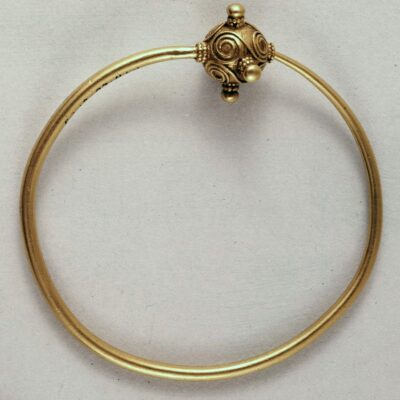
Italy, Fig (19) - Signet-ring and earring, Tharros, Italy, (7th - 6th c. BC), Gold, Semiprecious Stones, British Museum. 133454. © The Trustees of the British Museum.
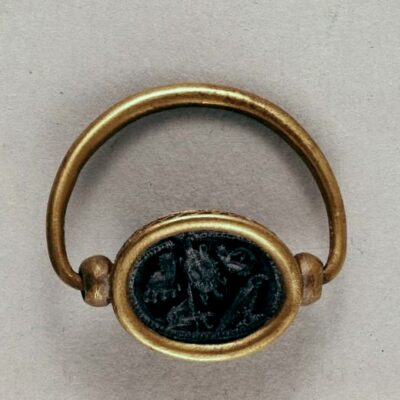
Italy, Fig (19) - Signet-ring and earring, Tharros, Italy, (7th - 6th c. BC), Gold, Semiprecious Stones, British Museum. 133454. © The Trustees of the British Museum.

Italy, Fig (18) - Diadem, Tharros, Italy, (7th - 6th c. BC), Gold, British Museum. 133392. © The Trustees of the British Museum.

Italy, Fig (20) - Bracelet, Tharros, Italy, (7th - 6th c. BC), Gold, Semiprecious Stones, British Museum. 135782. © The Trustees of the British Museum

Italy, Fig (20) - Bracelet, Tharros, Italy, (7th - 6th c. BC), Gold, Semiprecious Stones, British Museum. 135782. © The Trustees of the British Museum
Rabat, Morocco Musée National des Bijoux has some Phoenician pieces from the 5th c. BC. Two necklaces from Raggada have a center piece consisting of a round gold pendant with an eye in the center (Fig 21). The first one has successive beads of carnelian, turquoise frit and blue glass while the second has several gold cylindrical incised beads. From the same city come three gold earrings “à boisseau” consisting of three rings to which small boxes are attached (Fig 22).
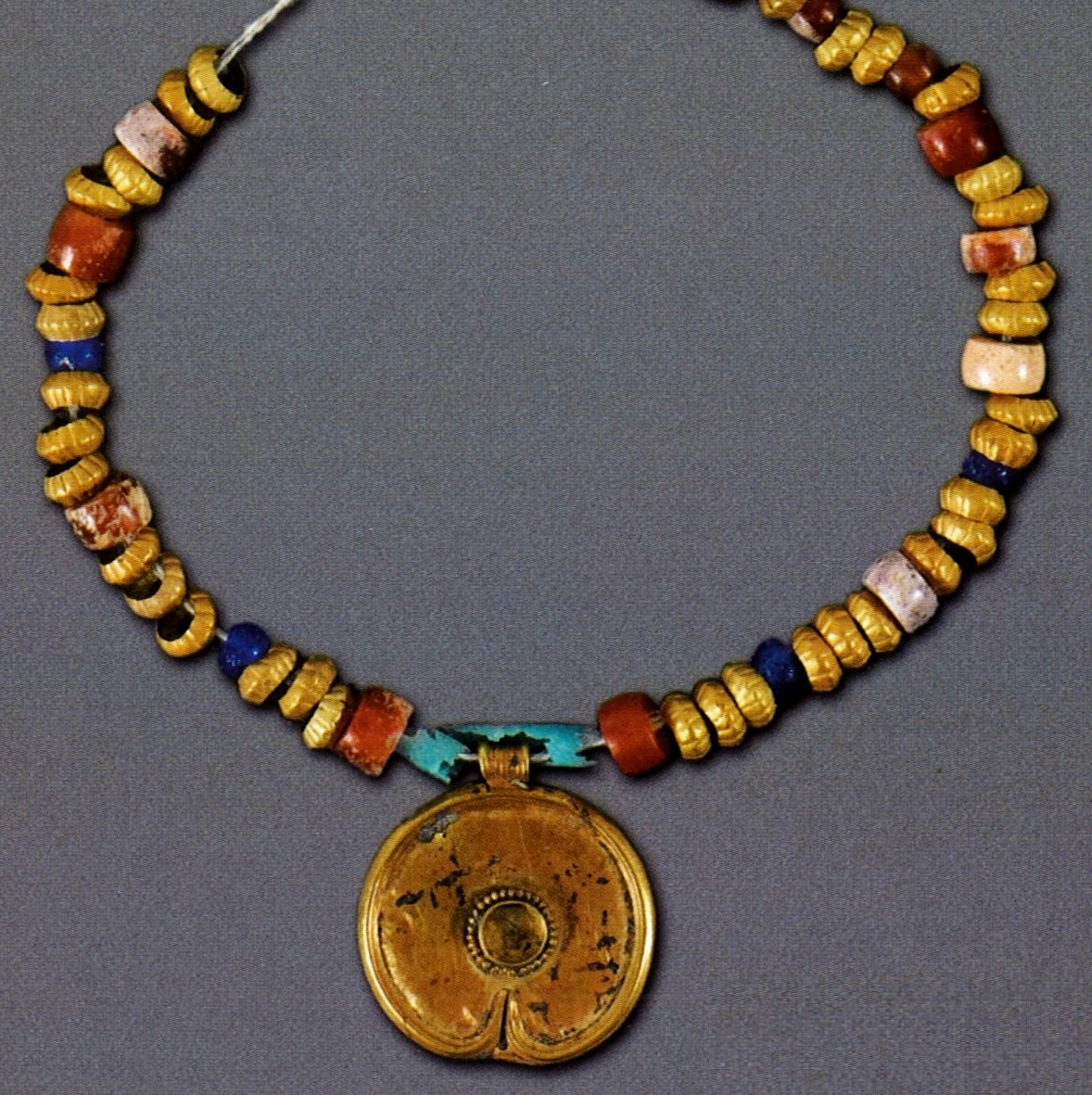
Morocco, Fig (21) - Two necklaces, Raqqada, Morocco, (5th c. BC), Gold, Semiprecious Stones, National Museum of Jewelry, Rabat. © Jean-Claude Lafitte.
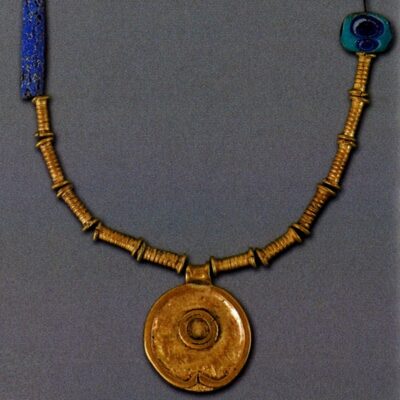
Morocco, Fig (21) - Two necklaces, Raqqada, Morroco, (5th c. BC), Gold, Semiprecious Stones, National Museum of Jewelry, Rabat. © Jean-Claude Lafitte.
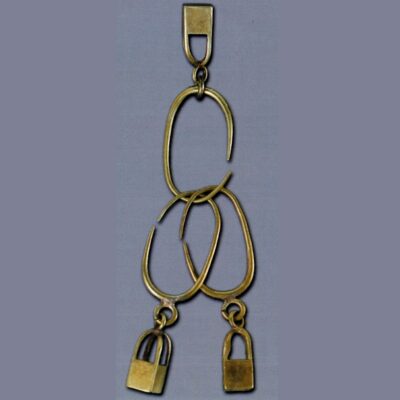
Morocco, Fig (22) - Three earrings, Raqqada, Morocco, (6th c. BC), Gold, National Museum of Jewelry, Rabat. © Jean-Claude Lafitte.
From Spain, comes the Treasure of El Carambolo found in El Carambolo hill three kilometers west of Seville from the 7th c. BC. It consists of 21 pieces of crafted gold: a necklace with pendants, two bracelets, two ox-hide-shaped pectorals, and 16 plaques that may have made up a necklace or a diadem (Fig 23). The pectorals show a unique mix of oriental motives and Atlantic techniques and technologies. Following Phoenician tradition, the jewelleries were found buried inside a ceramic vessel. Recent research suggests that the treasure may have been created by Phoenician craftsmen. The discovery site might be a sanctuary dedicated to the Phoenician goddess Astarte. The hoard is believed to have belonged to a group of priests who used the objects in their rituals in the sanctuary.
Phoenician presence in Portugal has long been confirmed. A treasure was found in a grave at Gaio, in the Cape Sines region, (5th or 4th c. BC) containing an important group of jewelry including a collar of gold-embossed plaques in Orientalizing style, large gold earrings of Tartessian-Galician type, and beads of gold, amber, tin and turquoise (Fig 24). Both the decorative motifs and granulation are mixed between Phoenician goldwork and the goldwork of the northern provinces of Portugal.
To conclude, the most common designs were either religious or plant-theme inspirations, such as the lotus flower, palmette, rosette, or animal themes such as scarab, hawk, sphinx, griffin and lion without forgetting geometric ornaments. The most widespread models are the gold earrings shaped in the form of ankh (crux ansata: cross with handle), crescent, leech, elongated sticks, or bushel, and ring models with a rectangular bezel or with rounded corners, the shape of a cartridge, often decorated with Egyptian-style. Showcases at the National Museum of Beirut tell the story of the Phoenician jewelry creation in an outstanding collection of gold necklaces, earthenware or carnelian, pendants, rings, bracelets and earrings. In observing all those pictures, we notice how many of these timeless jewels are still relevant to this day. This handicraft still inspires contemporary artists who adapt to today’s trend.
Perhaps the most significant legacy attributed to the Phoenicians was their mastery of the seas, which led them to establish the first grand commercial Mediterranean network. They were the masters of the Mediterranean, expanding from the Lebanese coast to beyond the Pillars of Hercules between the 8th and 6th centuries BC. They were able to import raw materials and export day-to-day products or items ready to be used or consumed. The hybrid identity as we call it is what made Phoenician products unique and expensive.

Spain, Fig (23) - The treasure of El Carambolo, Spain, (7th - 5th c. BC), Museo Arqueológico de Sevilla. © José Luiz Bernardes Ribeiro
The numerous places where Phoenician’s jewellery and their craftsmanship were found prove that the Phoenician’s trading stations and network ports included locations all over the Mediterranean and along the Atlantic shores of what are now Morocco, Spain and Portugal. There is evidence also attributed to them even farther, in the Azores as well as in coastal France and the UK. No material evidence was found on the American continent, but the ships Phoenicians were expertly able to build suggest that a journey through the Atlantic toward America was most probably possible.
“If anyone could have done it before Columbus, it was the Phoenicians.”
—Captain Philip Beale

Portugal, Fig (24 ) - The treasure of the necropolis of Gaio, Sines, Portugal, (5th or 4th c. BC).
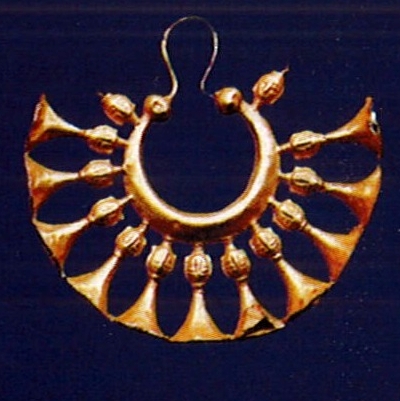
Portugal, Fig (24 ) - The treasure of the necropolis of Gaio, Sines, Portugal, (5th or 4th c. BC).
Bibliography
- Avanzini, A., & Sader, H. 2015. The Phoenician Exhibition. ENPI CBCMED.
- Cynthianne, D. S. 2015. Phoenician maritime pioneering and Punic expansion: reconstructing trade and dietary patterns (EAA 2014 Istanbul), The European Archaeologist
- Flourentzos, P., &Vitobello, M.L. 2009. The Phoenician gold jewellery from Kition, Cyprus, ArcheoSciences, 33 | 2009,
- URL: http://- https://journals.openedition.org/archeosciences/2135
- DOI : https://doi.org/10.4000/archeosciences.2135
- Moscati, S., 1998. The Phoenicians. Milan : Bompiani.
- Rutherford, T. 2021. Could Phoenicians Have Crossed the Atlantic?, AramcoWord, 72/3.
- Les dossiers d’archéologie, La Méditerranée des Phéniciens, HS – no 13 – Novembre 2007
- https://www.langantiques.com/university/phoenician-jewelry/
- https://www.worldhistory.org/tartessos/
- [1] https://www.gemsociety.org/article/myth-magic-and-the-sorcerers-stone/
————————————————————————————————————————————————————————————————————————————————————————————————————
About Aimée Bou Rizk,
MA in Archaeology, PhD student at the Lebanese University – Has participated in several excavations and restauration projects in Lebanon and Syria conducted by the Lebanese University, the American University of Beirut and le Musée de Préhistoire libanaise. Participated in a Museology workshop in Austria. Has been working as an RA and then a Museum Assistant at the AUB Archaeological Museum since August 2014.
About Nesrine Aad,
MA in Art and Archaeology – Has participated in several surveys, excavations, and conservation project in Lebanon and Iraq all in collaboration between the Lebanese University, Ballamand University and Chubu University Japan. Has also participated in Museology workshops in Jordan and France. Has been working as RA at AUB Archaeological Museum since Feb 2016.

